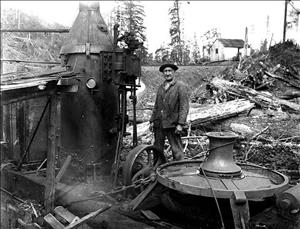In 1881, John Dolbeer (1827-1902) of Crescent City, California, invents the donkey engine and revolutionizes logging. A single-cylinder steam engine is connected to a horizontal capstan and they are mounted together on several log skids. By wrapping cables around the capstan, the engine can pull huge loads that would otherwise require animal power. The skid road and the ox team are rendered obsolete and the era of ground-lead logging begins. The donkey engine will appear at the Blanchard Lumber Company's operation on Bellingham Bay in 1887.
For many years, logging operations were limited to areas close to water where the logs could be floated to mills or to flat ground where animal power could be used. Horses and oxen dragged logs along roads paved with greased wood ties. The process was slow and expensive and the animals could not negotiate steep terrain.
On Dolbeer's first model, he wrapped a 150-foot, 4½ inch manila rope several times around a gypsy head (horizontally mounted spool) and attached the other end to a log. The donkey pulled the log toward the engine. The engine was moved by attaching the line to tree and pulling it along on its log skids. Similar pieces of machinery appear with names such as Humboldt, Tacoma, Willamette, Seattle, Crackerjack, Duplex, and Halfbreed.
In 1881, Ephraim Shay (1839-1916) of Michigan patented a geared locomotive, which made possible the rail transportation of heavy loads of logs up and down steep grades in all weather conditions. The Shay was basically a flatcar with a steam boiler mounted in the middle. Fuel and water were stored on opposite ends. Two vertical cylinders drove a crankshaft, which in turn drove a pair of geared trucks through a system of universal joints and sliding shafts (jackshafts). On most Shays, the boiler is offset to the left of center, to balance the cylinders on the right.
Northwest loggers proceeded to push inland from the coasts and rivers to supply the growing demand for lumber.

